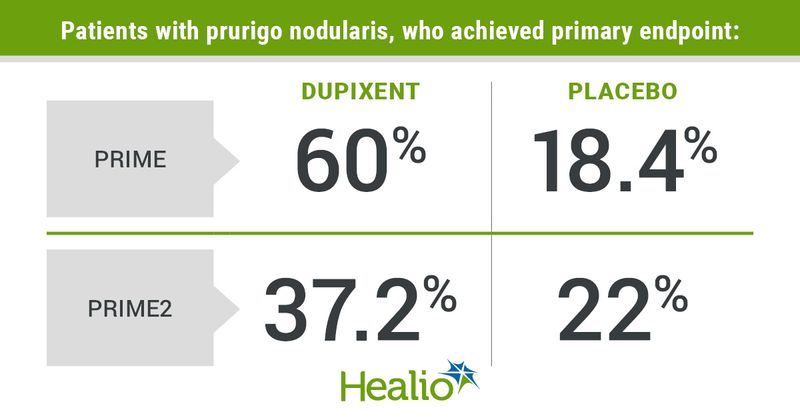Dupixent meets primary endpoints in first published results for prurigo nodularis
Key takeaways:
- These studies are the first published using Dupixent in this indication.
- The primary endpoint was met by up to 60% of Dupixent-treated patients compared with up to 22% of placebo-treated patients.
Results from two phase 3 trials evaluating Dupixent for the treatment of adults with prurigo nodularis have been published in Nature Medicine, making it the first data to be published in this indication.
“The publication of these phase 3 results in Nature Medicine provides a detailed look at the significant clinical benefit of targeting key and central drivers of type 2 inflammation with [Dupixent (dupilumab, Regeneron/Sanofi)] for adults with prurigo nodularis,” Gil Yosipovitch, MD, professor of dermatology at University of Miami Miller School of Medicine, director of the Miami Itch Center and principal investigator of the trial, told Healio.

“The extreme itch makes this disease have one of the highest impacts on a patient’s quality of life among all inflammatory skin diseases,” Yosipovitch continued, “and these data show that dupilumab can improve symptoms and health-related aspects of their lives that I see my patients struggle with every day.”

The studies, PRIME and PRIME2, enrolled 151 and 160 patients, respectively. Patients were randomly assigned to receive 300 mg dupilumab or placebo subcutaneously every 2 weeks for 24 weeks. The two studies had the same primary endpoint at two different time points: a proportion of patients achieving an at least 4-point reduction in Worst Itch Numeric Rating Scale at 24 weeks in PRIME or 12 weeks in PRIME2.
Results from PRIME showed that 60% of dupilumab-treated patients achieved the primary endpoint compared with 18.4% of placebo-treated patients (P < .001). In PRIME2, 37.2% of the dupilumab group achieved the primary endpoint vs. 22% of the placebo group (P = .022).
According to the study, key secondary endpoints, including a reduction in skin lesions, were also achieved by 48% and 44.9% of dupilumab-treated patients compared with 18.4% and 15.9% of placebo-treated patients in PRIME and PRIME2, respectively (P < .001 for both).
The drug also maintained a consistent safety profile with what is known of dupilumab. In PRIME, five dupilumab-treated patients and six placebo-treated patients reported serious treatment-emergent adverse events. In PRIME2, two patients in each group experienced the same.
According to the researchers, with the exception of one placebo-treated patient in PRIME who experienced two events of mesenteritis and sepsis, no adverse events were considered related to the study intervention.
